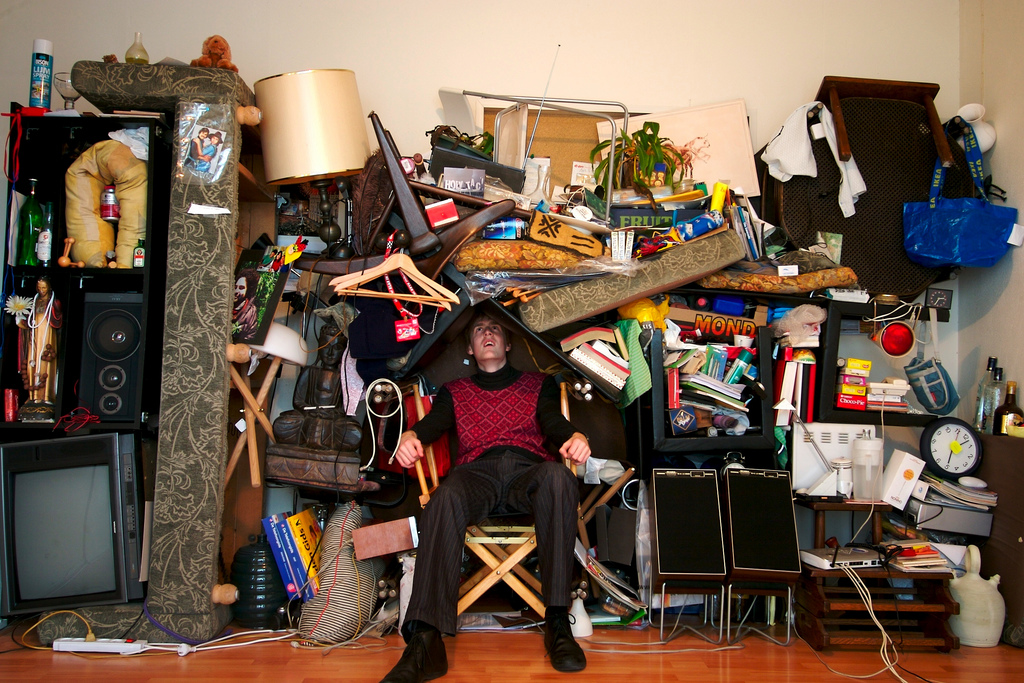
One of the themes of the last few months has been stuff – the physical items with which we surround ourselves. The impending addition of my son in September prompted a flurry of preparations and reconsideration of all our possessions. We started by sorting through all our baby gear. But, soon enough, we found ourselves shuffling our lesser-used Christmas ornaments and fancy china off to a new storage room. I spent my evenings sorting through memory boxes from my childhood and sending boxes of photos off to be digitized. And now, even though we’re away from most of our possessions (we’re travelling for two months), we still spend a fair amount of time schlepping suitcases from one location to another, packing and unpacking the things we brought, and organizing our items into new spaces to be functional.
All of this ‘stuff management’ has made me reflect upon how we manage our things – how we ensure that they are of service to us instead of us being of service to them. Long ago, when Liz and I moved in together, we agreed upon a number of guiding principles about how we would manage our combined stuff. It was less guidance that we aspired to but more an articulation of our already-shared philosophy. It included such guiding principles as:
One in/one out: The concept is simple: buy a sweater, get rid of a sweater. The challenge here is that you need to accurately baseline what you own at the start. This ensures you are not adhering to the letter of the law and unintentionally maintaining a bloated pants collection or never letting yourself buy the extra set of socks you need to make it through the week. But, if you follow the spirit of the thing, I find this principle is the most useful for maintaining day-to-day discipline.
Keep memories electronically: While the memories that our parents kept for us are very sweet, the volume of them is overwhelming. When I sorted through my memory boxes this fall, I found dozens of figure skating medals and reams of participation certificates. In sorting through our old boxes – and thinking prospectively for our kids – we try to keep memories electronically. This means that we try to take pictures of things and ditch the originals instead of accumulating more fodder for the memory boxes. Goodbye ticket stubs, programs, menus, and, yes, the little ones’ artwork. We have room for one work of art per child on the refrigerator, so pick your favorite, kiddo.
Maintain 30% extra space: Empty space begs to be filled. And yet, a home that is perfectly full – no space empty and nothing extra – does not give room for growth. I vaguely remember reading a feng shui article at one point which suggested that you need to leave empty space in your home in order for good things to arrive. Our target is that any closet, cupboard, or drawer can be 70% filled and should remain 30% empty. This is admittedly a tough one, but it’s always a good reminder for me when I am tempted to shove the Nth t-shirt in a drawer.
Let it go: When an item can serve others better than it can serve you, pass it on swiftly and without hesitation. This can be difficult for us because we’re both so frugal. That said, as we sold our San Francisco apartment and moved across the country to a Connecticut rental, we were reminded how owning, maintaining, and moving items requires the expenditure of real mental and physical energy. So, instead of hoarding ‘value’ by keeping things that we are unlikely to use again, we try to do the more comprehensive math of each item’s value to us, weighing our likelihood to actually use it versus the more intangible costs of ownership. This is not exactly Marie Kondo’s approach of disposing of things if they don’t bring you joy, but it has a similar ruthlessly cleansing result.
Since originally articulating our approach, we have also added new principles related to how we manage our stuff with kids. The best of these are:
Up to one toy: Both to manage our space and also to keep ourselves sane, we limit friends and family to giving “up to one toy” for holidays and birthdays. They are welcome to give an endless parade of books, clothes, and college fund contributions, but only up to one toy. Sometimes little things sneak through (particularly if they’re of the consumable kind, like crayons, stickers, or bath bombs), but we’re okay with that. The point is that we are trying to set limits upon the endless consumption of things so that we can make our boundaries clear with others and provide some of that discipline to our children as well.
Want/Need/Wear/Read: I can’t remember where we picked this one up, but before Elliott’s first Christmas, we decided that she would receive four and only four gifts from us for the holiday: something she wants, something she needs, something to wear, and something to read. The small number and delimited categories keep us from splurging on many things and force us to consider closely what we acquire.
As we step into the holiday season abundant with things – old things we’re using and new things we’re acquiring – it’s a good moment to reflect. How do you manage your stuff? What do you want your relationship with your stuff to look like? And, how can you bring intention to this part of your life?
Meredith

Totally agree. https://youtu.be/MvgN5gCuLac
LikeLike